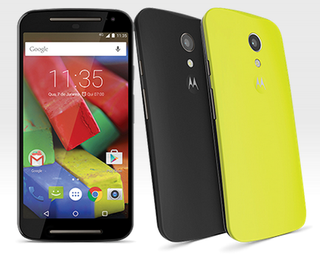Motorola Moto G 4G (2015) Comes To Brazil With Android Lollipop

When Motorola launched the original Moto G, the company tried to make the device as low-cost as possible while still offering enough performance and features that appeal to customers in emerging markets. LTE chips still add significant cost to a device, so early on, Motorola decided to put a 3G modem inside the Moto G. However, due to high demand for LTE support, Motorola later went back on its decision and launched a more expensive LTE version a few months later.
Motorola launched the 2nd-generation Moto G last fall, and now the company is launching a 4G LTE version, as well. As expected, the device doesn't come with major changes other than LTE support, although it does get a much-needed increase in battery size. The new Moto G 4G gets a 2,390 mAh battery, compared to the original Moto G 2nd gen, which had the same 2070 mAh battery as the smaller 1st-gen Moto G.
Adding a bigger screen but keeping the battery size the same has led to criticism of the Moto G 2nd gen, and that's likely the reason for the change. Motorola didn't put a bigger battery in the first Moto G 4G, so LTE must not have a significant impact on battery life compared to 3G on that device.
The other specs for the Moto G 4G (2015) are the same as for the Moto G 2nd-gen. It has a 5-inch 720p screen, quad-core 1.2 GHz Cortex A7 CPU from Qualcomm (the Snapdragon 400 -- still no Cortex A53-based Snapdragon 410, unfortunately), 1 GB of RAM, microSD support, 8MP rear camera, 2MP front-camera, FM radio and dual-SIM support. There won't be an 8 GB version, so the device comes with 16 GB by default. The phone will run Android 5.0.2 out of the box, which should make potential customers happy. (Motorola has already started updating older Moto Gs to Lollipop, so it wouldn't have made much sense to release the latest model with KitKat, anyway.
The Moto G 4G has only started selling in Brazil so far, on Motorola's local website, for a price of R$ 899, which is $336 USD. That's significantly more than a regular Moto G 2nd gen, although that price includes the upgrade to LTE, more storage, a larger battery and VAT and high Brazil tax imports.
Despite higher prices than in the U.S. or even Europe, previous Moto G models have been popular with Brazilians because they are still great, relatively low-cost options. Motorola hasn't said yet when the Moto G 4G will be available in other countries, but we don't anticipate that it will be much longer.
Follow us @tomshardware, on Facebook and on Google+.
Stay on the Cutting Edge
Join the experts who read Tom's Hardware for the inside track on enthusiast PC tech news — and have for over 25 years. We'll send breaking news and in-depth reviews of CPUs, GPUs, AI, maker hardware and more straight to your inbox.

EKWB reportedly plagued with financial disarray — many employees and suppliers were allegedly left unpaid for as long as four months

Adding ZIP file support to Windows 30 years ago almost got the creator of Task Manager fired

Carry-on server flexes up to 256 cores — 480TB NVMe and 4TB RAM join Ampere Altra CPU in new fly-away-kits
-
chesterman I can confirm that the Moto G is ridiculously popular here in Brazil. The arrive of a LTE model will just confirm this favoritism.Reply -
geok1ng As soon as BLU's VIVO IV starts trickling across the paraguayan border, Motorola will have a harder time selling Moto Gs on Brazil.Reply -
sephirotic I'm Brazillian, I have a 2gb 4G LTE plan, and I say: LTE IS GIMMICK, specially in Brazil. Signal coverage of LTE is particularly bad, even on the best cellphone companies, I keep LTE disabled for most of the time to save battery. (poor LTE signal = horrid battery consumption) WDCMA has more than enough bandwidth (average 8mbps, theoretical max: 20mbps+). Who needs to download things at 64mbps on a smartphone? Be serious. 8mbps is more than enough for watchin 1080p youtube videos, which is already stupid since for a 5" screen this is overkill. This is also true for other countries too, but specially in Brazil where data plans are ridiculous expensive, signal is unreliable, and even people that have expensive cellphones, still use pre-paid plans with only 10mb per day of data limit. I'd rather have a cheaper 3g smartphone.Reply
By the way, I bought a S4 1 year ago instead of the first gen moto G because it didn´t have a microSD slot. At least Moto G fixed that. I think the 2nd gen Moto G has a screen too big. I think 5" is nice, owning a S4, but the original size 4.7 paired with the 5" Moto X and smaller prices seemed a much more reasonable pair of options, too bad about the original Micro SD card. People on forums keep asking for recommendations of good phone between 500~600 Reais, and the new Moto G is just out of reach for those people.
Most Popular


